( TYPE 1 ) Fast, short and weak striker ( 137 CA ) as Target Forward
( TYPE 2 ) Strong, tall and slow striker ( 140 CA ) as Target Forward
RESULT:
As you can see despite having a higher "star" rating as TF and a higher CA with TYPE 2 attributes, it still produces a worse result.
Btw, there's nothing surprising in that result because as I said, we've tested that many times already, just read through this thread or some others.
If you're getting any different results in your own tests then it's because you test for not enough matches or your testing mythology has issues.
Cheers. Expand
<3 Thanks for the test! Have your stored the resulting save games by chance? I would love to compare some of the stats from both test cases to see where it differs from the one I've ran!
Zippo said: It has been tested and proven many times that Acceleration and Pace attributes are much more valuable than Strength and Jumping Reach for any striker role.
Speaking other words, if you have TF role in your tactic then with a fast and short striker for that role your result always will be much better than if you had a strong, tall but slow striker. Expand
I've just had a lightbulb moment. The reason small, speedy "target" forwards outrank more traditional target forwards has absolutely nothing at all to do with target forwards. It's because (being quick and fast) they're better at pressing.
Pressing is king. The reason speed and acc kill everything else in the attribute tests is because they're the #1 best way to improve your pressing effectiveness. Not only does the ball presser arrive sooner, but all his teammates will rotate quicker behind him.
That quicker forward gets to his man quicker, but he also is quicker to break into space if the press wins the ball elsewhere on the field.
If the meta wasn't so gegenpress-dominated, I think there'd be more room for big, slow target forwards. Currently, for a slow forward to pull their weight they need to bring something else to the party, whether that's playmaking or set pieces or something.
Sincere apologies if everyone else realized this ages ago and I'm just a little slow to pick up on it
detroitrex said: I've just had a lightbulb moment. The reason small, speedy "target" forwards outrank more traditional target forwards has absolutely nothing at all to do with target forwards. It's because (being quick and fast) they're better at pressing.
Pressing is king. The reason speed and acc kill everything else in the attribute tests is because they're the #1 best way to improve your pressing effectiveness. Not only does the ball presser arrive sooner, but all his teammates will rotate quicker behind him.
That quicker forward gets to his man quicker, but he also is quicker to break into space if the press wins the ball elsewhere on the field.
If the meta wasn't so gegenpress-dominated, I think there'd be more room for big, slow target forwards. Currently, for a slow forward to pull their weight they need to bring something else to the party, whether that's playmaking or set pieces or something.
Sincere apologies if everyone else realized this ages ago and I'm just a little slow to pick up on it Expand
I like your idea. That probably holds some truth. I would also consider the opposition matchup in this case. The fact that centerbacks in the test league have 13 Acceleration, 13 Pace, 15 Jumping Reach, 15 Strength.
The "short" striker has 15 acceleration and 15 pace. So despite lacking jumping reach and strength, he has a clear advantage in overall speed compared to the centerbacks he plays.
The "tall" striker has 12 Acceleration, 12 Pace, 18 Jumping Reach, 16 Strength. The "tall" striker is disadvantaged speed-wise but has a jumping reach and slight strength advantage over the centerbacks he plays.
Obviously, there are more changes than the 4 attributes listed. However, it seems to me that losing the pace advantage for a moderate aerial advantage seems not to be worth it. Even for the target forward role.
I ain't 100% sure yet, but I tested this Ciro Immobile. And I am beginning to develop the suspicion that the single most important attribute for a striker is not pace, height or acceleration. It's "off-the-ball".
In a fit of irony, Mbappe underlines this with his current spell at Real. And players like Filippo Inzaghi who made it look so easy that they got mocked for it.
The problem I see with pacy strikers is that you need to pass the goal for them into the goldilocks zone, between the defender & goalkeeper before they're offside. And then they need to outrun the last defender and the goalkeeper AND do a placed shot or lob WHILE running at high speed and being under high pressure by both players. Thus the gap in pace & acceleration between the striker vs defender & goalkeeper needs to be more than just 1-2 attribute points.
Having high jumping reach works, but only as long as the jumping reach is higher than the goalkeeper's aerial reach, or the defender's jumping reach. So you'd need a striker who has just 1-2 jumping reach more than the goalkeeper's aerial reach, and you'd notice the difference. But finding a striker who has 17+ jumping reach is still difficult and even then, you have to deal with off-sides.
With off-the-ball movement, you're having your striker duel it out against the defender's positioning. And having high off-the-ball also means fewer offsides. Here 1-2 attribute points ahead of the defender's positioning seems to be enough to score goal after goal.
---
The bias we see, I believe, with Acceleration, Pace & Jumping Reach is because of the way the positions work. The current meta tactics of 4-2-2-2 & 4-2-3-1 use 6/10 outfield positions that require speed & stamina. 2DMs (acting as BWM), AML+AMR, DL+DR.
Jumping reach is beneficial to goalkeepers, defenders & strikers, who seem to score more goals from set pieces if they have high jumping reach, but not so many goals otherwise. Thus there's 4/10 positions
The only position that seems to become broken with high off-the-ball movement is striker. It does not seem to contribute as much to any other position, at least not that I could observe.
The other attribute I hadn't paid as much attention to so far has been Aggression, which seems to synergize well with OTB.
I would expect the game to become broken if you have 20 OTB strikers, 20 PAC/ACC wingers, DLR & 20JR Defenders + Goalkeepers.
Ofc pacy tall strikers like Haaland & Osimhen will overperform at all times.
Possebrew said: I am beginning to develop the suspicion that the single most important attribute for a striker is not pace, height or acceleration. It's "off-the-ball". Expand
Above + 20 off the ball (for 2 strikers) = +93, 93 2nd sample = +92, 90
Looking at the striker stats specifically, there was no improvement, taken together they were overall slightly worse in line with the overall team result.
Zippo said: @svonn
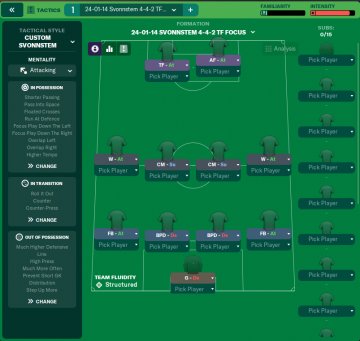
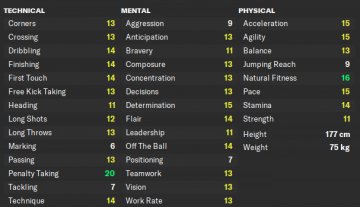
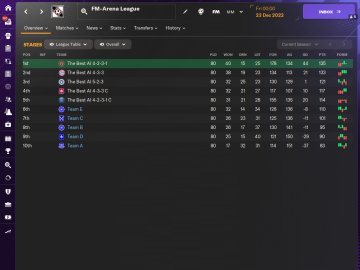
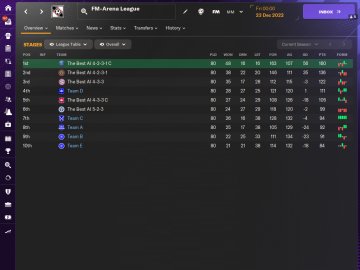
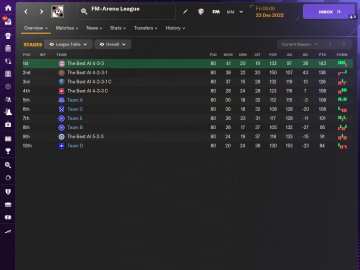
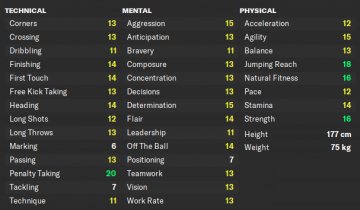
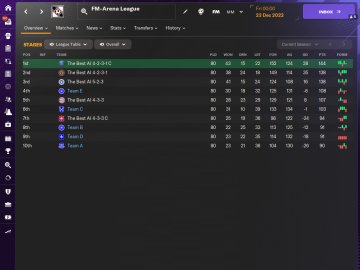
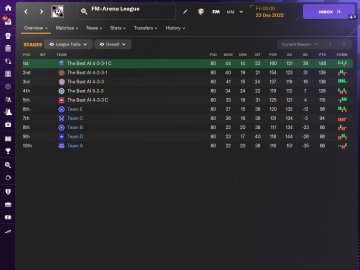



This tactic - https://fm-arena.com/thread/8910-wingplay-target-forward-test-tactic/
( TYPE 1 ) Fast, short and weak striker ( 137 CA ) as Target Forward
( TYPE 2 ) Strong, tall and slow striker ( 140 CA ) as Target Forward
RESULT:
As you can see despite having a higher "star" rating as TF and a higher CA with TYPE 2 attributes, it still produces a worse result.
Btw, there's nothing surprising in that result because as I said, we've tested that many times already, just read through this thread or some others.
If you're getting any different results in your own tests then it's because you test for not enough matches or your testing mythology has issues.
Cheers.
<3 Thanks for the test! Have your stored the resulting save games by chance? I would love to compare some of the stats from both test cases to see where it differs from the one I've ran!
Zippo said: It has been tested and proven many times that Acceleration and Pace attributes are much more valuable than Strength and Jumping Reach for any striker role.

Speaking other words, if you have TF role in your tactic then with a fast and short striker for that role your result always will be much better than if you had a strong, tall but slow striker.
I've just had a lightbulb moment. The reason small, speedy "target" forwards outrank more traditional target forwards has absolutely nothing at all to do with target forwards. It's because (being quick and fast) they're better at pressing.
Pressing is king. The reason speed and acc kill everything else in the attribute tests is because they're the #1 best way to improve your pressing effectiveness. Not only does the ball presser arrive sooner, but all his teammates will rotate quicker behind him.
That quicker forward gets to his man quicker, but he also is quicker to break into space if the press wins the ball elsewhere on the field.
If the meta wasn't so gegenpress-dominated, I think there'd be more room for big, slow target forwards. Currently, for a slow forward to pull their weight they need to bring something else to the party, whether that's playmaking or set pieces or something.
Sincere apologies if everyone else realized this ages ago and I'm just a little slow to pick up on it
detroitrex said: I've just had a lightbulb moment. The reason small, speedy "target" forwards outrank more traditional target forwards has absolutely nothing at all to do with target forwards. It's because (being quick and fast) they're better at pressing.

Pressing is king. The reason speed and acc kill everything else in the attribute tests is because they're the #1 best way to improve your pressing effectiveness. Not only does the ball presser arrive sooner, but all his teammates will rotate quicker behind him.
That quicker forward gets to his man quicker, but he also is quicker to break into space if the press wins the ball elsewhere on the field.
If the meta wasn't so gegenpress-dominated, I think there'd be more room for big, slow target forwards. Currently, for a slow forward to pull their weight they need to bring something else to the party, whether that's playmaking or set pieces or something.
Sincere apologies if everyone else realized this ages ago and I'm just a little slow to pick up on it
I like your idea. That probably holds some truth. I would also consider the opposition matchup in this case. The fact that centerbacks in the test league have 13 Acceleration, 13 Pace, 15 Jumping Reach, 15 Strength.
The "short" striker has 15 acceleration and 15 pace. So despite lacking jumping reach and strength, he has a clear advantage in overall speed compared to the centerbacks he plays.
The "tall" striker has 12 Acceleration, 12 Pace, 18 Jumping Reach, 16 Strength. The "tall" striker is disadvantaged speed-wise but has a jumping reach and slight strength advantage over the centerbacks he plays.
Obviously, there are more changes than the 4 attributes listed. However, it seems to me that losing the pace advantage for a moderate aerial advantage seems not to be worth it. Even for the target forward role.
I ain't 100% sure yet, but I tested this Ciro Immobile. And I am beginning to develop the suspicion that the single most important attribute for a striker is not pace, height or acceleration.
It's "off-the-ball".
In a fit of irony, Mbappe underlines this with his current spell at Real.
And players like Filippo Inzaghi who made it look so easy that they got mocked for it.
The problem I see with pacy strikers is that you need to pass the goal for them into the goldilocks zone, between the defender & goalkeeper before they're offside. And then they need to outrun the last defender and the goalkeeper AND do a placed shot or lob WHILE running at high speed and being under high pressure by both players. Thus the gap in pace & acceleration between the striker vs defender & goalkeeper needs to be more than just 1-2 attribute points.
Having high jumping reach works, but only as long as the jumping reach is higher than the goalkeeper's aerial reach, or the defender's jumping reach. So you'd need a striker who has just 1-2 jumping reach more than the goalkeeper's aerial reach, and you'd notice the difference. But finding a striker who has 17+ jumping reach is still difficult and even then, you have to deal with off-sides.
With off-the-ball movement, you're having your striker duel it out against the defender's positioning. And having high off-the-ball also means fewer offsides. Here 1-2 attribute points ahead of the defender's positioning seems to be enough to score goal after goal.
---
The bias we see, I believe, with Acceleration, Pace & Jumping Reach is because of the way the positions work. The current meta tactics of 4-2-2-2 & 4-2-3-1 use 6/10 outfield positions that require speed & stamina. 2DMs (acting as BWM), AML+AMR, DL+DR.
Jumping reach is beneficial to goalkeepers, defenders & strikers, who seem to score more goals from set pieces if they have high jumping reach, but not so many goals otherwise. Thus there's 4/10 positions
The only position that seems to become broken with high off-the-ball movement is striker. It does not seem to contribute as much to any other position, at least not that I could observe.
The other attribute I hadn't paid as much attention to so far has been Aggression, which seems to synergize well with OTB.
I would expect the game to become broken if you have 20 OTB strikers, 20 PAC/ACC wingers, DLR & 20JR Defenders + Goalkeepers.
Ofc pacy tall strikers like Haaland & Osimhen will overperform at all times.
Possebrew said: I am beginning to develop the suspicion that the single most important attribute for a striker is not pace, height or acceleration.
It's "off-the-ball".
I was curious about this so I did a test
20 pace/acc/jump/drib/pass + 8 others = +100, 96
2nd sample = +96, 95
Above + 20 off the ball (for 2 strikers) = +93, 93
2nd sample = +92, 90
Looking at the striker stats specifically, there was no improvement, taken together they were overall slightly worse in line with the overall team result.